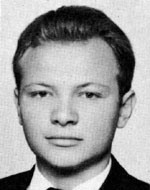Safran, Meir
Son of Yosef and Atti. He was born on September 28, 1948 in Cyprus, in the refugee camps of the Jewish immigrants. He studied at the Ramle-Lod High School and completed his studies in the real-world track. He belonged to the Hanoar Haoved movement and was a counselor in the movement. Meir was interested in scientific work and in 1965 he participated in a competition for models in the natural sciences and mathematics (after the late Joseph Shapira of the Weizmann Institute in Rehovot) and his memory was awarded to a participant in the competition. And in his estate there is a notebook of poems that are all connected to the fate of a man, who, by the way, was hidden by him and was not known until after the news of the disaster was known: a quiet, modest and restrained boy responsible for every role he was assigned. In August 1966 he was drafted into the IDF and joined the Navy. He volunteered to serve in the submarine squadron because he saw in this type a combination of two different forms of service: the service of a soldier fighting in the first line of fire on the one hand, and on the other hand the service of a professional. In June 1967 he was ordained as a diver. He loved the sea and adventure and when he came to serve in the submarine he was Simcha. In his letters home he described the intensity of his experiences that he had spent in the long metal block of his submarine. His attraction to the sea and one of his connections when he was a student at the school concluded: “After a fierce struggle with the sea waves, the ship escaped and returned safely to the port.” Perhaps it was the laugh of fate, and perhaps it was Meir’s feeling that the ship in which he was serving would not be rescued from the sea and its sailors would not bring her back safely to the port. At the time of his induction, his mother did not object to her because she believed in her son and in the corps he belonged to. The Six-Day War found him in the submarine “Crocodile” when he excelled in its operations. Among his poems is one poem called “The Fate of Man,” which is found in three situations – peace, love and war, but “to convert fate can not be human because he is human and flesh.” In his last poem, which is found in the poems notebook, there is a passage – in which words and sentences are recorded, such as: My feet felt in the hot vibrating water / which brought the victim into them … / The water rises and rises around … / The water rises and rises. “I’m dead – I’m drowning!” He seemed to feel the truth when he wrote the song, and after satisfying the successes he had learned during his training in England, he joined the crew of the Dakar submarine that was about to return to the port. Was found on the 25th of Tevet 5724 (January 25, 1968) in the sea lane between Gibraltar and Israel, the connection with it was severed – and again it was not renewed.the Chief Military Rabbinate determined that the date of Meir’s death, in the course of his duties together with the rest, On January 30, 1968. As Meir was one of the missing members of the team, a memorial monument was placed inside him in the memorial to the Dakar men in the military cemetery on Mount Herzl in Jerusalem. The Municipality of Lod dedicates a page in his memory: In the book of Eran Shorer, “Six days in Dakar” his name was immortalized by bringing his picture on 28.5.1999, after years of searching, “Dakar” on the bottom of the Mediterranean Sea, at a depth of 2900 m on its planned sailing route and 250 miles from the port of Haifa. The space is a machete – a space whose burial place is unknown
